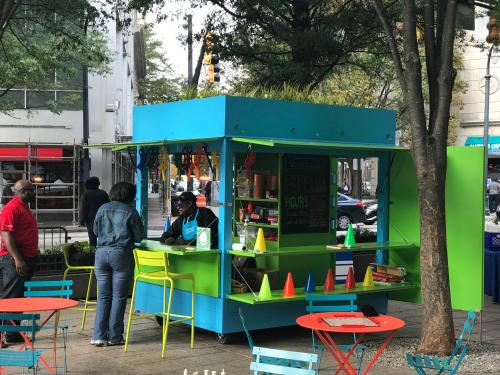Placemaking Postcards is a blog series from the Bass Center for Transformative Placemaking at Brookings where policymakers and practitioners guest-author promising placemaking efforts from across the U.S. and abroad that foster connected, vibrant, and inclusive communities. In line with the principle tenets of placemaking, the goal of the series is to recognize the community as the expert, highlight voices from the field, and to create a community of learning and practice around transformative placemaking.
 Cities are made up of communities, and it is at the community-level that people build relationships, foster local assets, and mobilize residents to enact change. But people and organizations within communities can be disconnected from each other, and even more disconnected from the broader systems and structures that shape their collective well-being.
Cities are made up of communities, and it is at the community-level that people build relationships, foster local assets, and mobilize residents to enact change. But people and organizations within communities can be disconnected from each other, and even more disconnected from the broader systems and structures that shape their collective well-being.
The COVID-19 pandemic has made these disconnects more obvious, highlighting the disparities that render certain neighborhoods (predominantly low-income neighborhoods, racially segregated neighborhoods, and neighborhoods exposed to environmental racism) and certain people within those neighborhoods (low-wage workers and those living in crowded housing) disproportionately vulnerable to the virus.
As cities around the world imagine new ways to “rebuild better” from the pandemic, it is crucial that these efforts bridge the divides that fuel place-based inequities both within and across communities. One way to do so is by strengthening and connecting the community-led structures that mobilize residents, organizations, and institutions into coordinated action for systemic change. A place-based effort from East Scarborough, Toronto illustrates the promise of this approach.
A city of divided neighborhoods
Toronto is often described as a “city of neighborhoods,” and over recent decades, the economic, social, and physical inequities between those neighborhoods have deepened significantly. Toronto’s inner suburbs, in particular, are increasingly home to racialized concentrations of poverty, while the downtown core has become wealthier and whiter.
In 2014, the city of Toronto designated 31 of its 140 neighborhoods as Neighbourhood Improvement Areas (NIAs), meaning those neighborhoods require focused resources and investment to thrive. NIAs are home to some of Canada’s richest diversity, cultural pride, and grassroots organizers. They also share many indicators of structural inequity, including high rates of working poor, deep poverty, racial segregation, dense apartment towers and other forms of housing stock in disrepair, and transit poverty.
East Scarborough, an inner suburban area in Toronto’s east end, is home to five NIAs and the largest concentration of the city’s working poor. Kingston-Galloway-Orton Park (KGO)—the neighborhood I was born in—is a NIA in East Scarborough that faces particularly stark disparities, as the intersecting issues of poor public transit, deteriorating housing, high unemployment, and racism converge to keep approximately 40% of its households in poverty.
Still, KGO has always been home to a strong foundation of community organizations, grassroots groups, and social service entities working to improve residents’ lives. In 2008, one such organization—the East Scarborough Storefront—decided it was time to weave together KGO’s sometimes fragmented community-building efforts in order to advance collective solutions firmly rooted in local knowledge. This work began with a cross-sectoral, community-led design initiative, and has since inspired new public investment in the neighborhood and fostered the creation of a lasting civic organization dedicated to advancing opportunity for residents of East Scarborough and beyond.
Bridging divides through community design
East Scarborough’s Community Design Initiative (CDI) was born out of an understanding that efforts to improve neighborhood conditions are often siloed between disciplines (social work, urban planning, economic development, community development, etc.) that use different tools, processes, and words to accomplish similar goals. CDI strived to shift this paradigm using a place-based approach to connect groups around a coordinated, community-led revitalization strategy.
CDI began as a collaboration between the East Scarborough Storefront, architectural think tank archiTEXT, and architecture firm Sustainable that brought together local KGO youth and design professionals to revitalize a former police station into a much-needed community facility. But the goals of the project were broader than co-creating a community space—they sought to leverage design as a mechanism for inspiring participatory, cross-sectoral investment in social, economic, cultural, environmental, and civic neighborhood well-being for years to come.
The Storefront functioned as the community backbone organization for the effort, meaning they were responsible for building a collaborative partnership between the youth, architecture and design firms, landlords (private and public), funders, the city councilor, and city staff. This required designing and facilitating the project to address power dynamics, build upon everyone’s strengths, and maintain lasting partnerships. While typical planning projects engage communities through public information-gathering sessions with little true partnership, CDI ensured that residents had the power to decide the end result of any and all changes in physical design.
To shift the paradigm for community design and community-led neighborhood revitalization, the initiative:
- Ensured a trusted, place-based organization with deep relationships in the community (also known as a community backbone organization) facilitated the multidisciplinary effort
- Intentionally shifted community power imbalances by giving residents all final decisionmaking power
- Made it clear that all strategies would be emergent and reflect the true aspirations of the community, rather than having a predetermined outcome in mind
- Prioritized deep investment over the long term by designing a multiyear strategy with partners and funders to sustain the project
In 2014, CDI resulted in the transformation of the former police station into an inviting space where grey concrete blocks were painted bright orange, glass meeting rooms replaced former jail cells, and a community kitchen replaced dark offices. The most exciting result of CDI was the Sky-o-Swale—a green innovation that turned the police station parking lot into an award-winning, one-of-a-kind elevated bioswale featuring a water irrigation system, shade structure, and performance stage developed with repurposed materials.
In the years since, CDI’s successes have inspired larger, more long-term physical improvements in the neighborhood. That includes being designated a Tower Neighbourhood Renewal site by the municipal government, which put residents in the driver’s seat to improve a local apartment tower through community-led design.
Not only did CDI inspire new municipal investment and physical improvements in the neighborhood, but it also informed the Storefront’s Connected Community Approach for advancing place-based community and economic development in Toronto’s NIAs and surrounding communities. CDI has also led to the creation of a new permanent civic organization—the Centre for Connected Communities (C3)—which is dedicated to putting these principles into action.
Creating lasting civic structures through bottom-up design
In 2018, the East Scarborough Storefront launched C3 to continue coordinating grassroots groups, community-based organizations, funders, developers, employers, and governments at all levels in implementing holistic strategies for fostering community connections and inspiring neighborhood improvements. C3 now works in several NIAs across Toronto to advance community-based neighborhood resilience strategies, place-based workforce development strategies, and grassroots leadership strategies.
As we recover and rebuild from the COVID-19 pandemic, we are presented with an urgent imperative: Rebuild better by centering disconnected and disenfranchised communities and instigating holistic, systemic change. Supporting community-led civic structures is one vital component of this strategy, and it requires unlocking the potential of connected communities to do so.
Photo credit: The East Scarborough Storefront






Commentary
How a community-led design initiative in Toronto is redefining neighborhood revitalization from the bottom-up
September 16, 2020